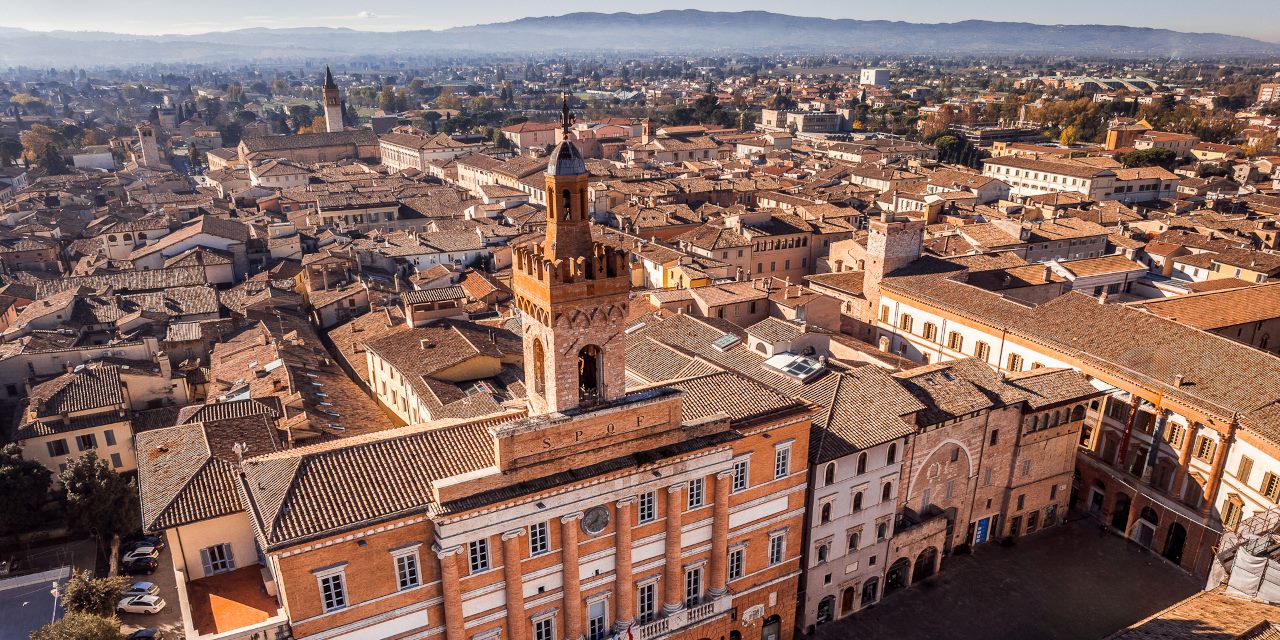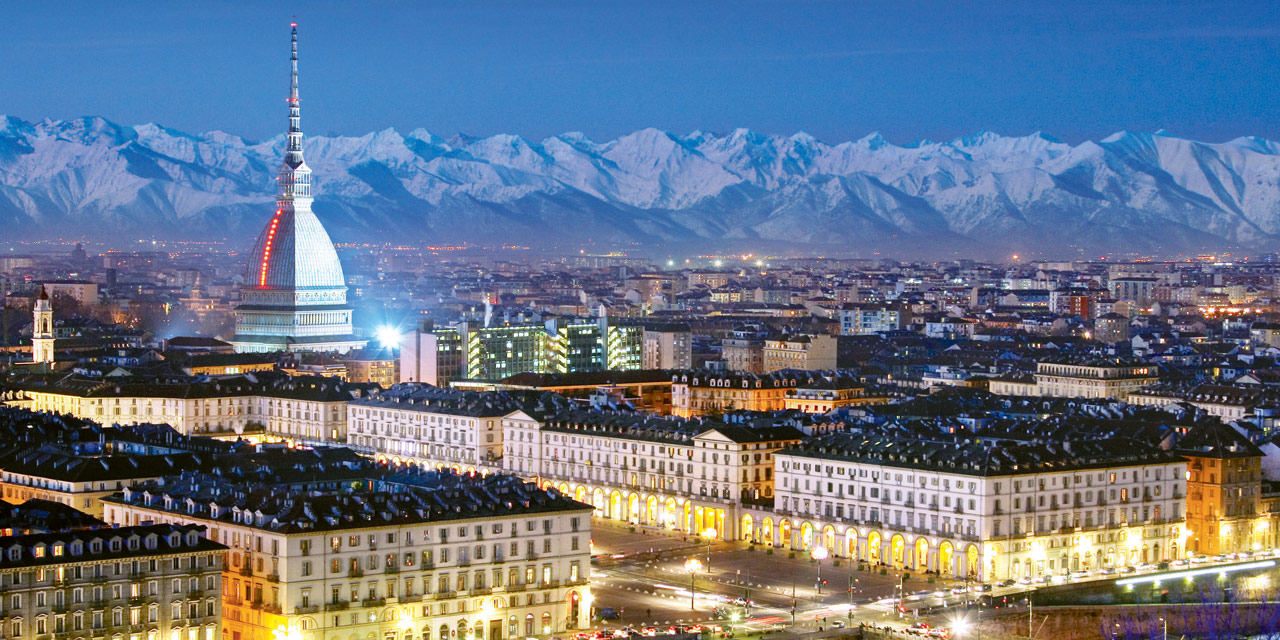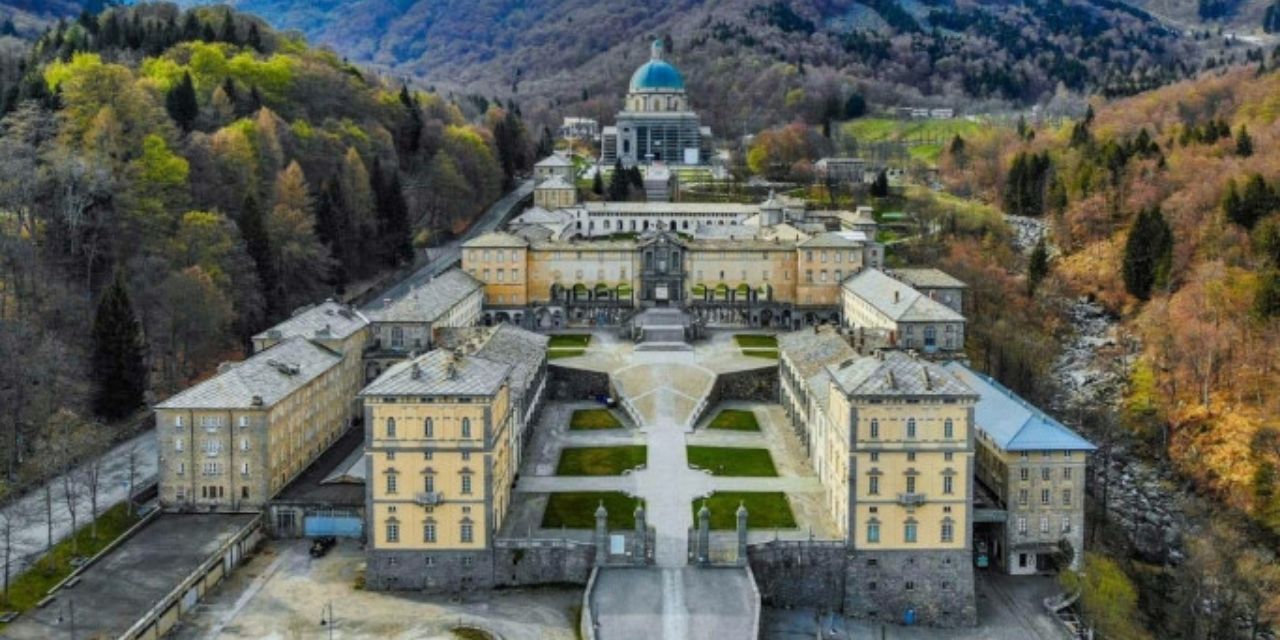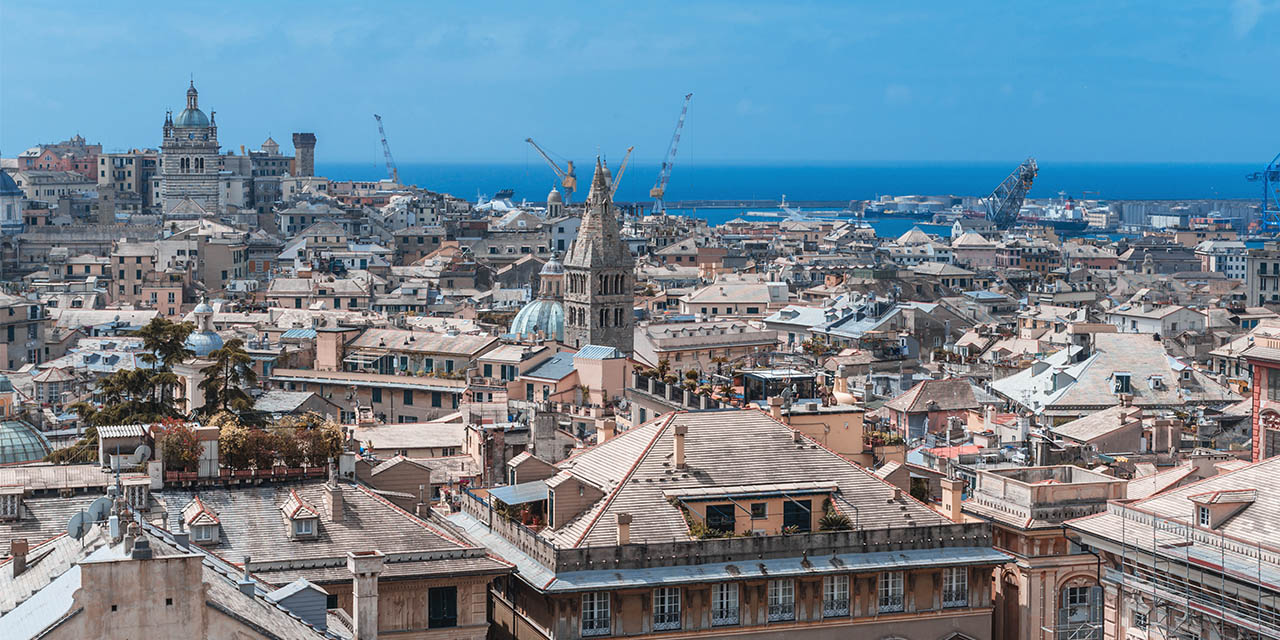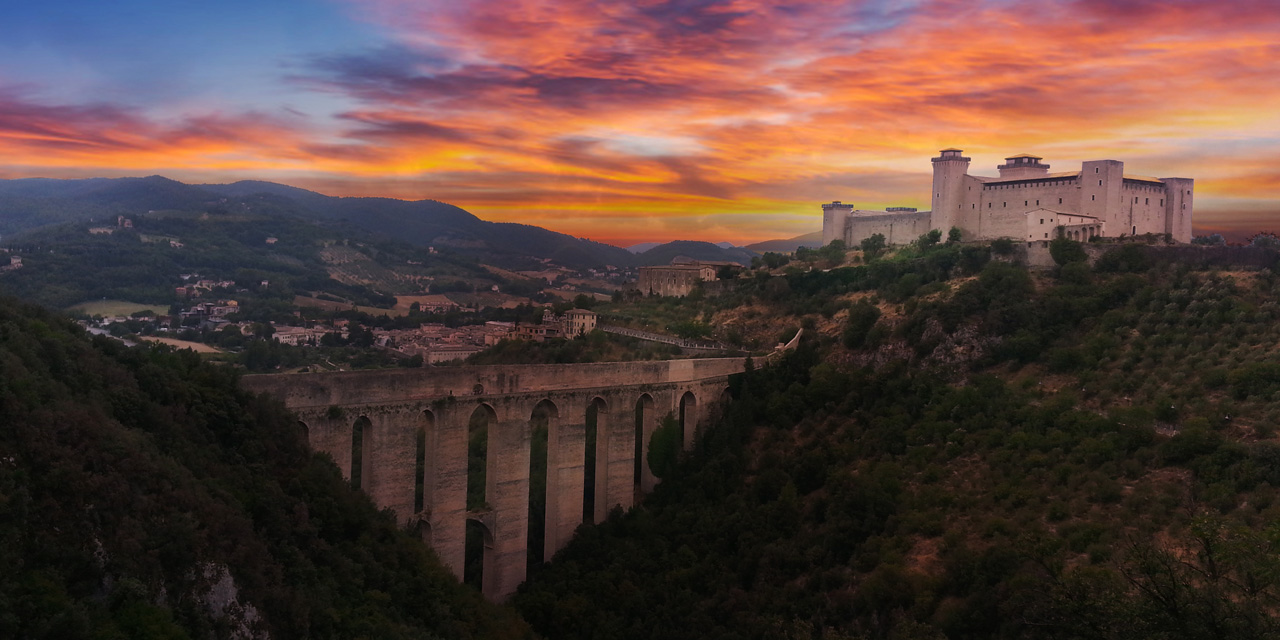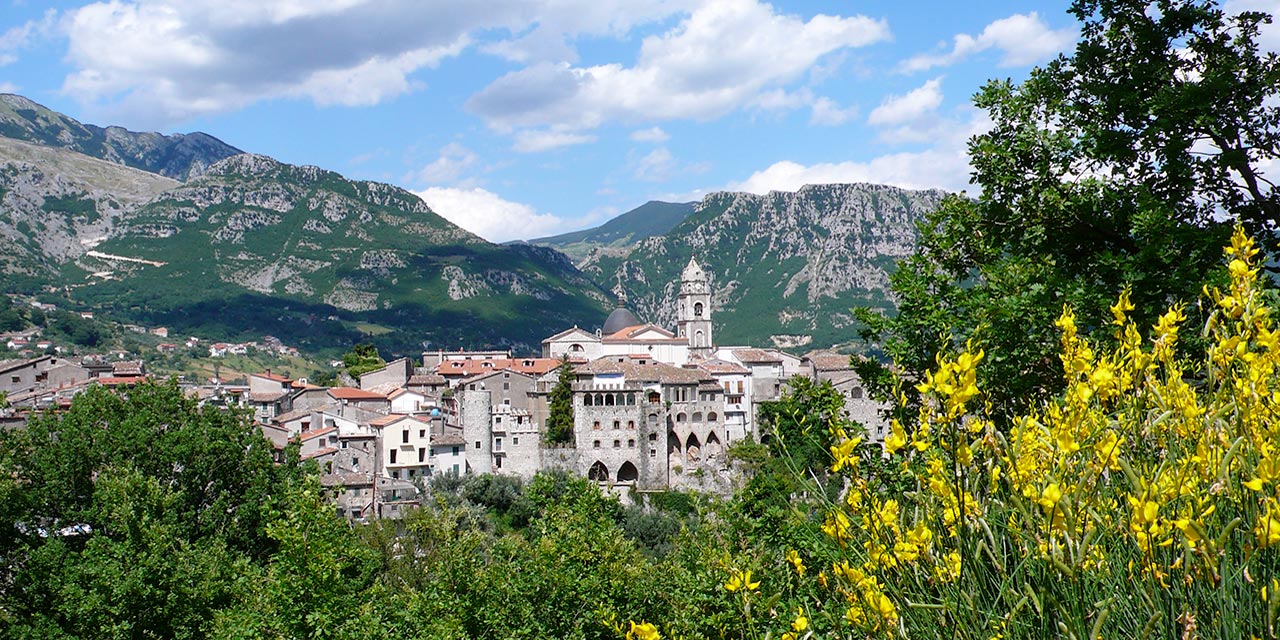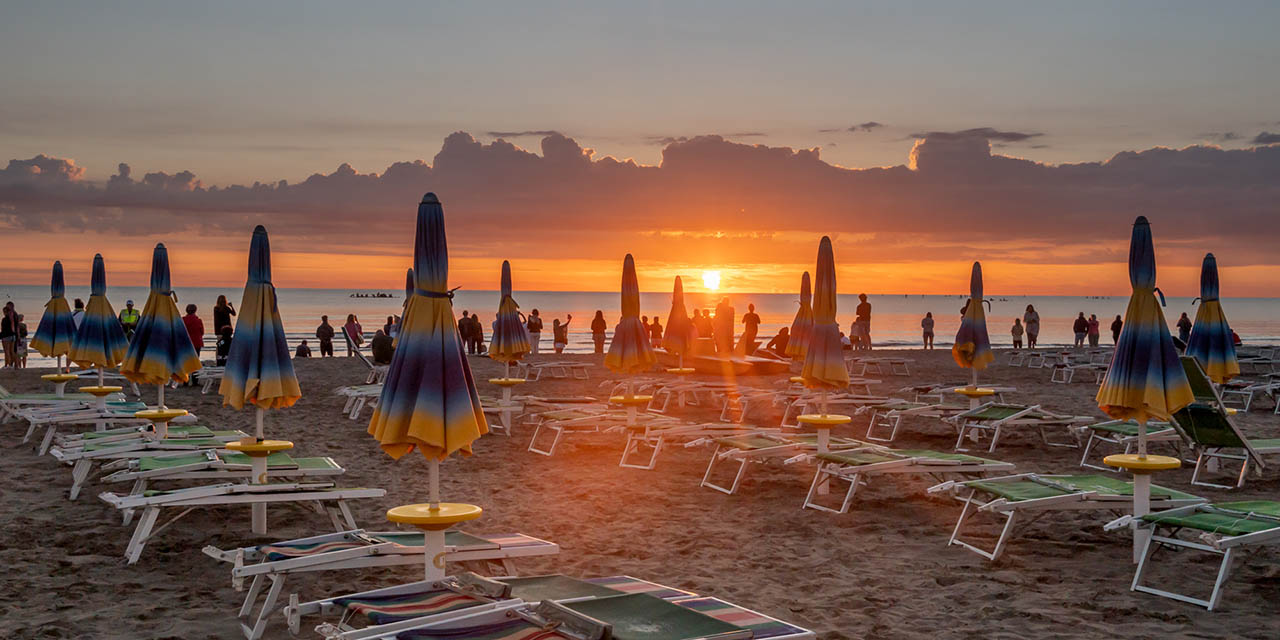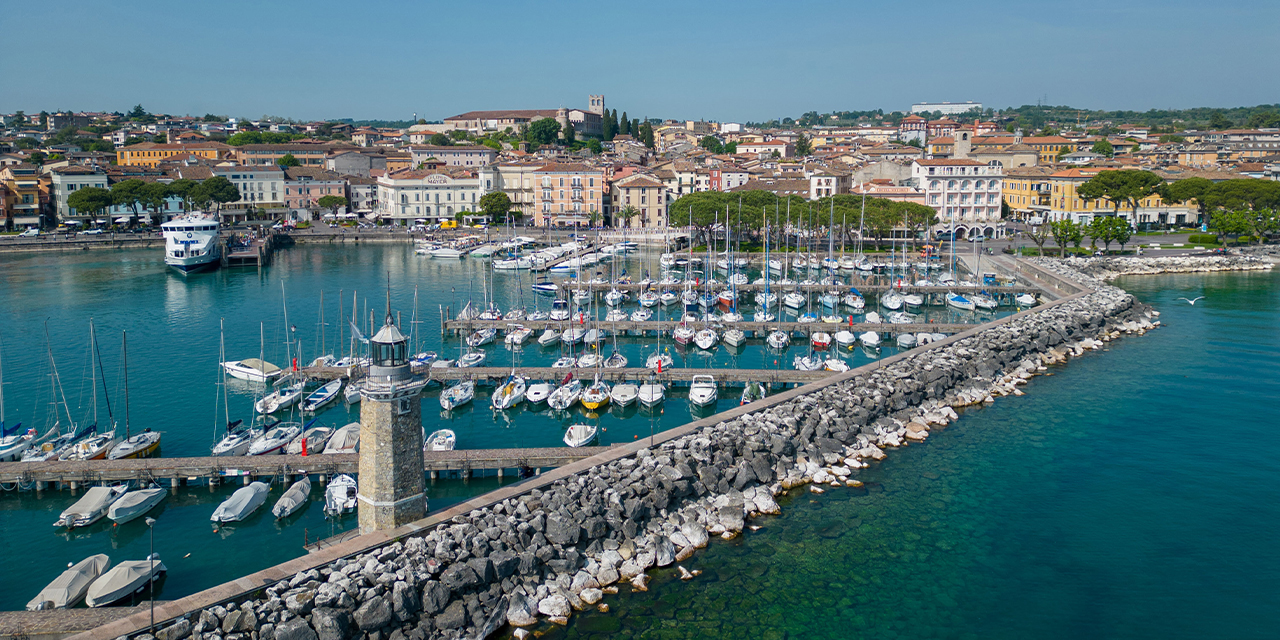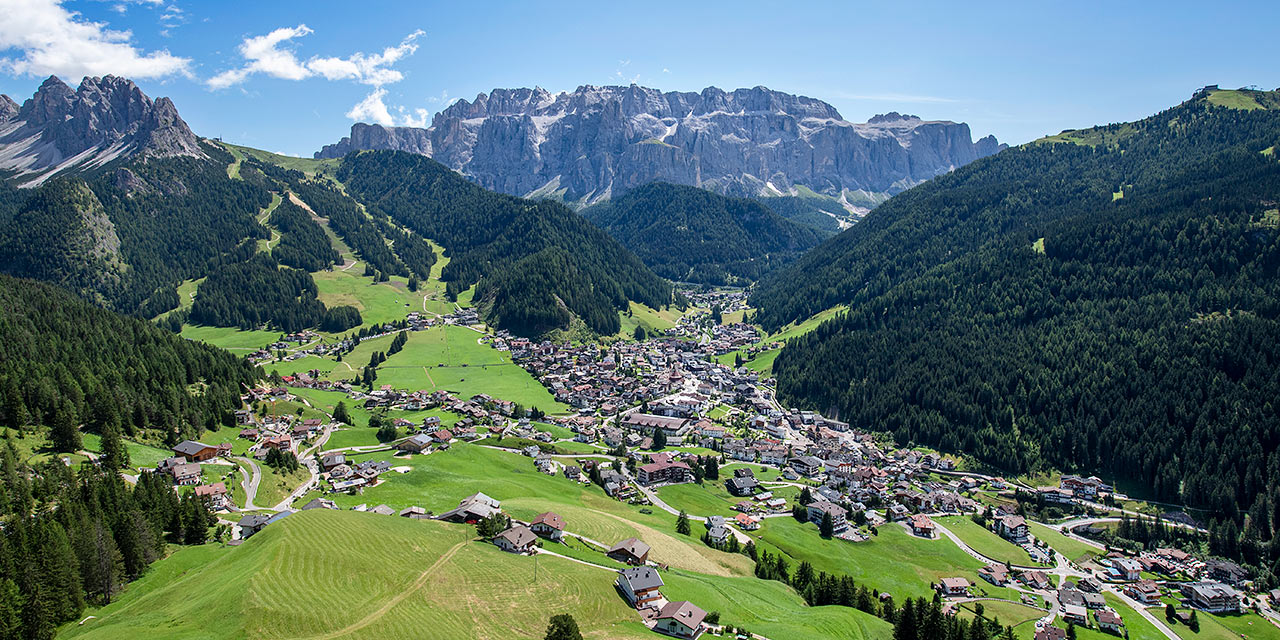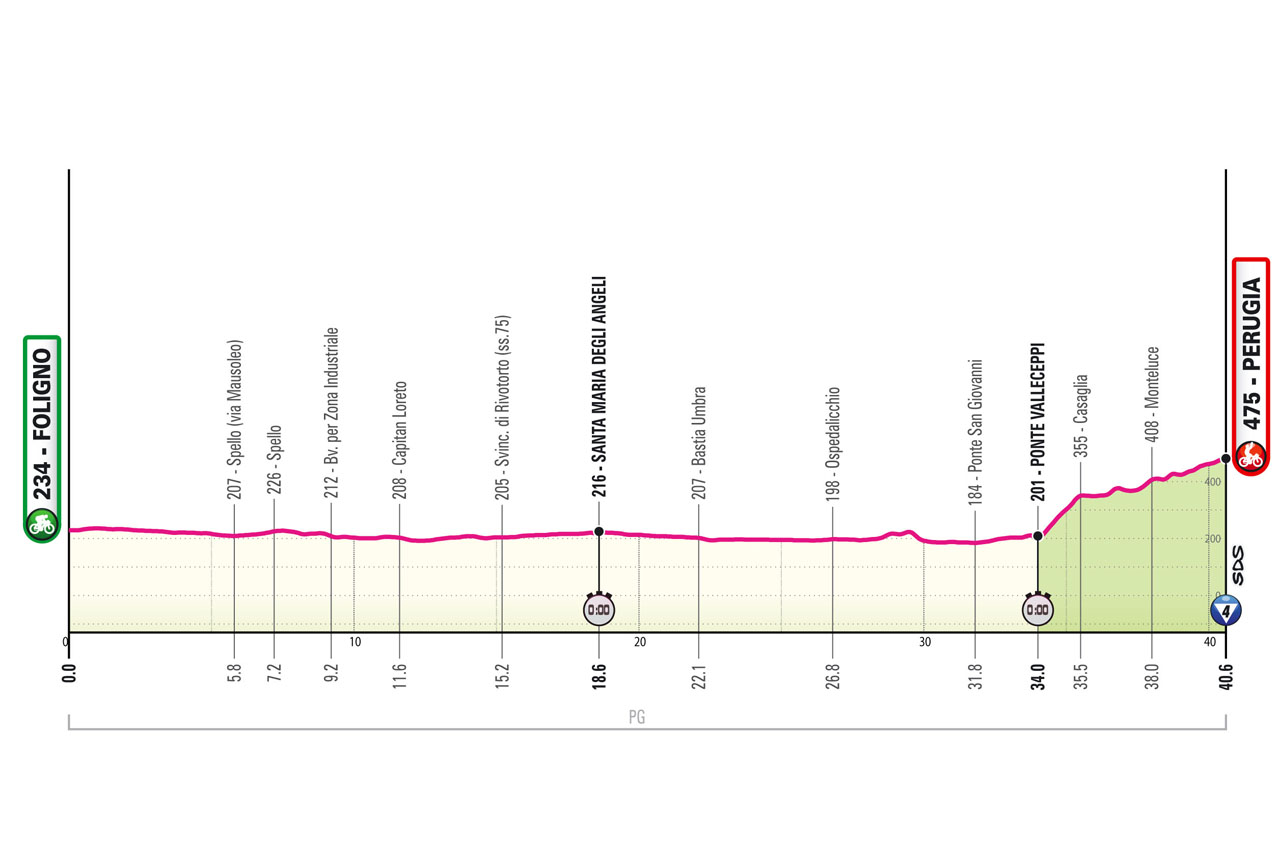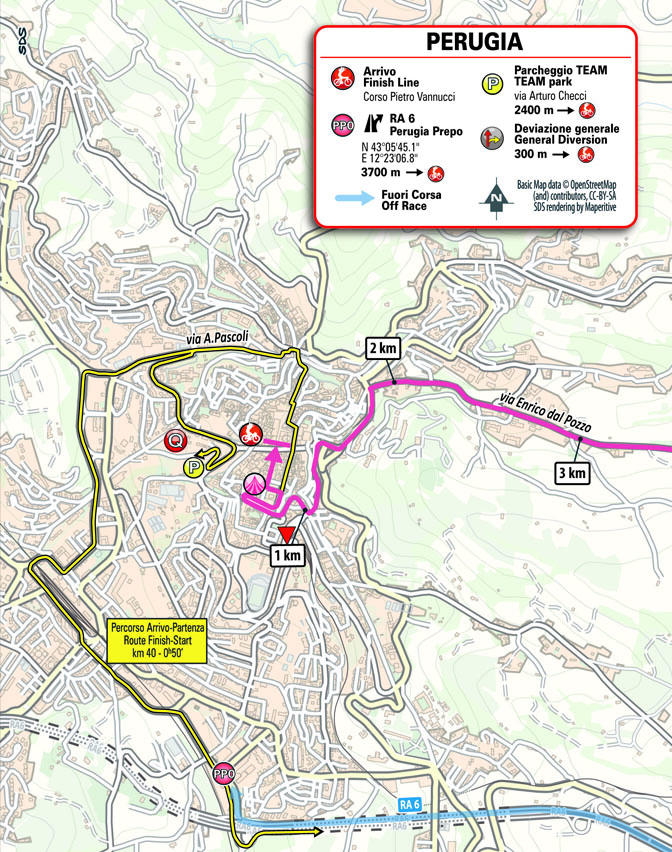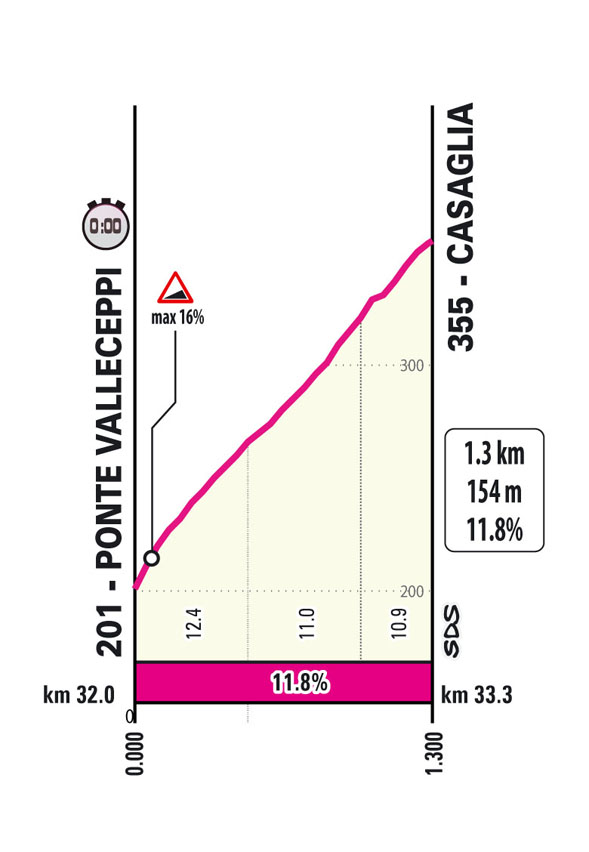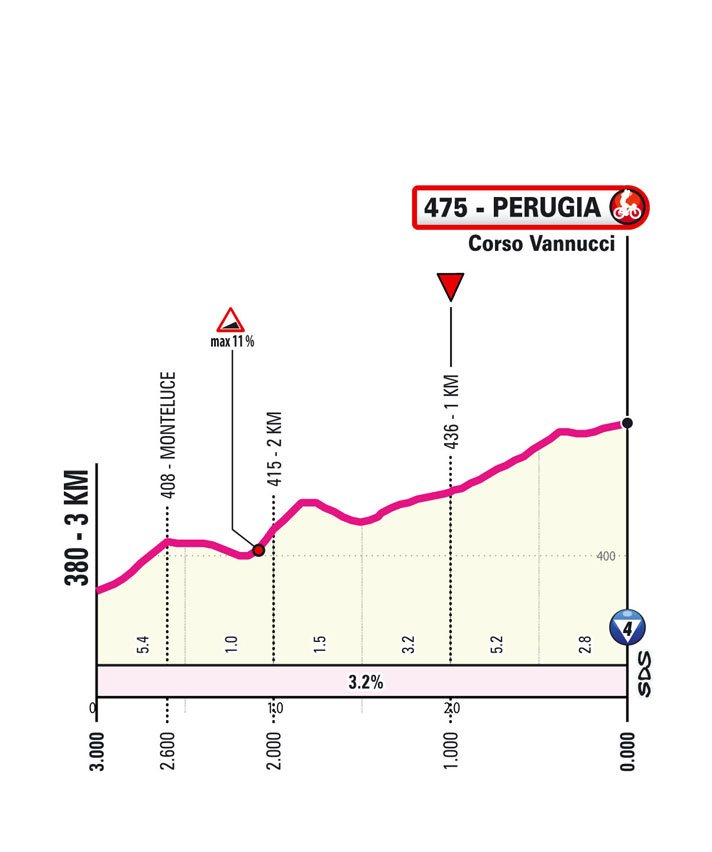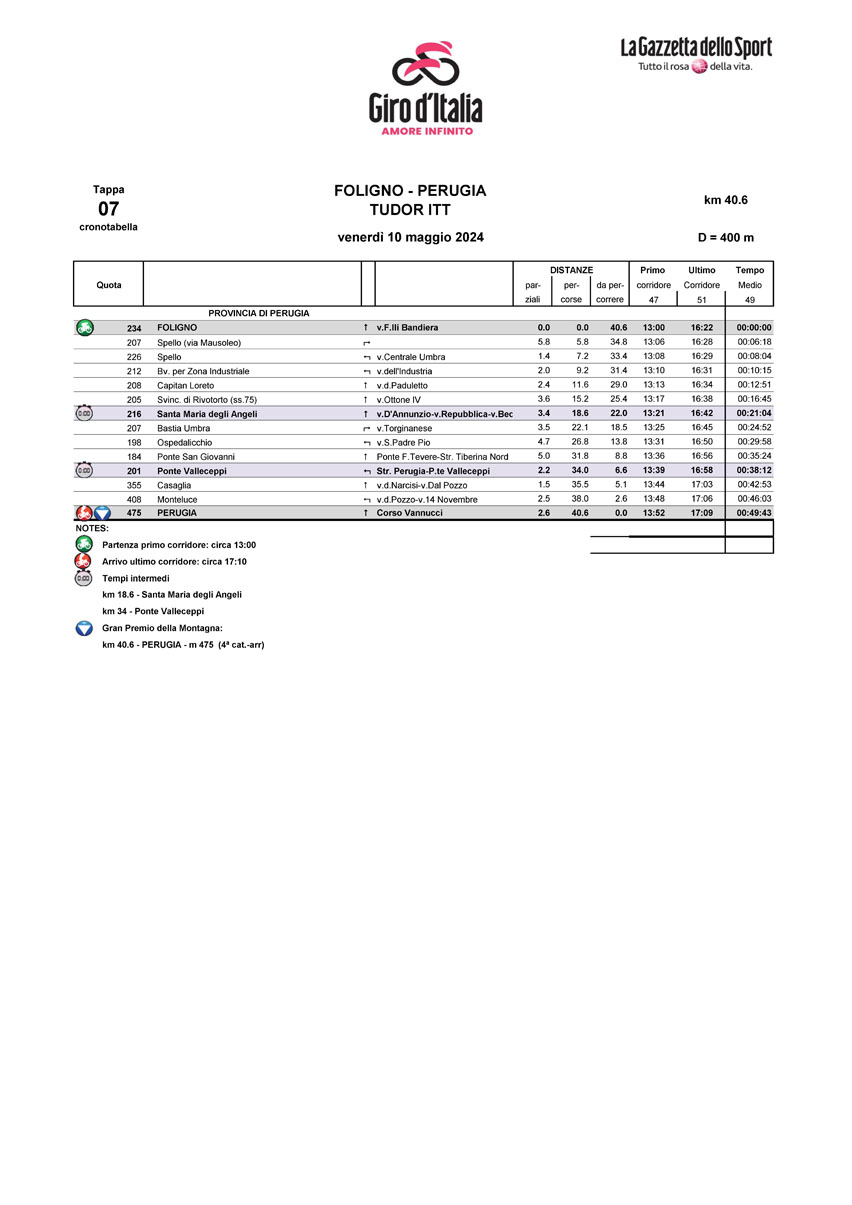profile
map
technical info
Individual time trial clearly divided into two parts. The first 32 km, flat and largely non-technical, lead to the foot of Umbria’s capital city of Perugia. The riders then tackle the ascent of Casaglia, with gradients up to 16%. The road climbs in fits and starts all the way to the finish line.
Last kilometres
The last few kilometres are all uphill with gradients reaching double figures. Several bends and counter-slopes before the wide final hairpin bends leading to the final straight. To be noted at 6.4 km from the finish line the 1300 m of Casaglia at almost 12% with peaks of 16%. Final straight of 250 m on a 6 m wide cobbled road.
start / finish
climb detail
final kilometres
itinerary timetable
tourist info
Host city:
Foligno
Overview
Located along the Via Flaminia – one of the main roads leading to Rome – the ancient Fulginium, currently Foligno has a rich history and culture, along with plenty of culinary traditions. It sure deserves a visit to please your eyes, clear your mind and treat your taste buds.
Lying halfway between the more renowned Perugia and Assisi, the city is an excellent destination, all round. Strategically located as a major road and railway hub, the city expanded repeatedly over time, and even grew outside the old town centre in the modern age, towards the surrounding plains. The original oval shape, now lost in the tangled web of the suburbs, can still be seen from the hills, when descending from Montefalco, or along the Menotre river valley. Wide tree-lined avenues lead from the four cardinal points to the city gates, Porta Romana and Porta Todi, woven together by the ancient city walls. River Topino flows to the north, while one of its inner branches passes through some of the most picturesque parts of the city that were the seat of ancient production facilities. There are gardens just outside the walls, and lovely piazzas within. Major landmarks include the Neoclassical-Baroque cathedral (named after the patron saint of the city), the Town Hall (with the iconic features of a 13-century building), Palazzo Trinci (with its stunning Gothic staircase), Palazzo Orfini (named after the typographer who printed the first Italian edition of the Divine Comedy) and its amazing 16-century gate, and Piazza della Repubblica, the beating heart of the city.
Foligno – the third largest city in Umbria – is now a lively trade hub, with a population of approx. 60,000.
Speciality food
Local cuisine offers a wealth of traditional Umbrian delicacies such as legume soups (especially grass pea), bruschette topped with olive oil, fresh handmade pasta (such as strangozzi and pappardelle) seasoned with wild game sauce or truffle, lamb roast and the famous coratella. Local specialties also include the iconic pizza al formaggio (cheese bread) and its sweet rendition, made for Easter. When it comes to cakes, rocciata is a must-taste. This local rendition of the strudel, richer and tastier, is best paired with a glass of fine Sagrantino wine. Typical local produce include Colfiorito red-skinned potatoes, whose sweet and fragrant yellow flesh is used for making gnocchi, or cooked in embers.
Main sights
Palazzo Trinci (XIV secolo), Cattedrale di San Feliciano (XII-XIX secolo), Abbazia benedettina di Sassovivo (XI secolo), Museo della Stampa (Palazzo Orfini, XVI-XVII secolo), Calamita Cosmica di Gino de Dominicis (Arte contemporanea, chiesa SS Trinità), Parco di Colfiorito (Area naturale protetta), Valle del Menotre (Pale e Rasiglia).
Perugia
Overview
Foundation: the first known settlements in the territory dates back to the XI and X Century B.C., with the appearance of Villanovian villages in the proximities of the strata of the Perugian hills and, since the VIII Century B.C., also upon the summit of the hill where the city will eventually rise.
Perched on a hill, at nearly 500 meters of altitude, Perugia dominates from the acropolis the entire Tiber valley (Valle del Tevere). Powerful Etruscan center and then important medieval city, Perugia has maintained intact its reputation of illustrious and lively cultural center throughout the centuries. Seat of a prestigious University over 700 years old, of the Academy of Fine Arts, of the Conservatorium of Music and of the University for Foreigners, Perugia welcomes students from all over the world as proof of the strong international vocation of the city.
For the tourist who desires an evocative entry to the acropolis, it is mandatory to go through the Rocca Paolina. Historical-architectural complex unique in its kind, it is the “casket” of the medieval city. Perfectly preserved, once inside, you are magically transported to another era.
Crossed by modern escalators that help the ascent to the heart of the city between historical vestiges and contemporary suggestions, Perugia is a city full of “secrets” to be revealed. The suggestion is to explore it with curiosity in order to fully enjoy the emotion and the charm of the discovery, as once witnessed by the visitors of the Grand Tour and as still now do the many tourists and students who come and stay.
From the XIII Century Fontana Maggiore an enchanting path unravels among the five districts that from the acropolis, like the fingers of a hand, open to the visit: a series of ups and downs, streets and alleys, narrow streets and stairways, unusual and picturesque views that cross still splendidly preserved traits of the Etruscan-Roman and medieval walls.
Public and private museums, palaces and fountains, workshops of artistic craft products, a typical cuisine that tells the taste and love for their land, make Perugia a place where stopping is not only a restorative break.
Being here means living the experience of a city still on a human scale, where ancient, modern and contemporany history coexist in harmony and in the dialogue between different cultures and religions. A place that will amaze you, for its ability to play, to mix emotions and suggestions, from chocolate to art. Here you will be able to admire the works of Perugino, Pinturicchio and Raffaello; the contemporaneity of Burri and Beuys, among the notes of Umbria Jazz, of the Sagra Musicale Umbra; to enjoy the rich theatre season; to walk along the streets of the city center meeting perhaps the Captain of ventura, Braccio Fortebracci, during the days of Perugia 1416.
Speciality food
Perugia’s cuisine, as well as all Umbrian gastronomy, is very simple and not particularly elaborate and its typical seasonal products enrich the meat dishes (sheep, pork and game) that are the real specialties of the region. The undisputed protagonist of Perugia’s cuisine is without any doubt the precious black truffle of Norcia that is used above all for the preparation of appetizers and first courses (also the white truffle of Val Tiberina is very used in Umbrian cuisine).
Another much appreciated dish is gnocchi al sugo d’oca (gnocchi is a particular pasta made with boiled potatoes and flower, here served with goose meat ragù), a true specialty of Perugian cuisine that are prepared purely by hand and are seasoned with tomato, oil, garlic, pieces of young goose and semi-seasoned pecorino cheese.
Another dish we recommend is Palombacci alla Perugina, wild pigeons which are cooked in earthenware saucepans.
These wild pigeons are salted and peppered both internally and externally and then wrapped in slices of prosciutto (ham).
Lastly, the famous Torta al testo, one of the most popular dishes of Umbria.
This white focaccia has the particular characteristic that it is not made to rise,;it is stuffed with vegetables, ham and cheese and is cooked on the “testo” which is a stone heated or placed upon the fireplace embers.
Drinks
Along the course of the Tiber we find a specific DOC of Perugian wines. With it, other DOC representing the territory with red wines, also of a certain aging and white wines of remarkable freshness.
In the province of Perugia the two DOCGs of the region: the red Montefalco Sagrantino produced with the Sagrantino autochthonous grapevine (or so believed) even though its origins are uncertain: it could be of Iberian origin as well as Saracen (with the dry and passito variants) and the Torgiano Rosso Riserva, produced with Sangiovese grapevine.
In the province of Perugia nine of the DOC produced in the region can be found.
The Assisi is produced with the grapevines Trebbiano toscano, Grechetto, Sangiovese, Cabernet sauvignon, Merlot, Pinot nero as well as specific vines cultivated in Umbria (with the variants white, grechetto, red, rosato, novello, cabernet sauvignon, merlot and pinot nero, the last three also in the reserve type).

